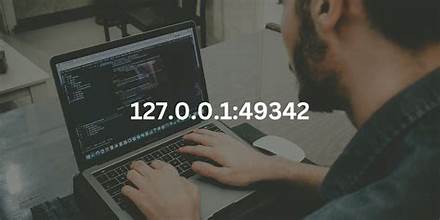127.0.0.1:49342: Understanding Localhost Connections and Ports

When working with network systems or software development, understanding how different IP addresses and ports work is crucial. One of the most common IP addresses encountered is 127.0.0.1:49342, which is typically associated with local server connections. This article will explore what 127.0.0.1:49342 means, its significance, and how it fits into the broader world of networking.
Table of Contents
What is 127.0.0.1:49342?
To begin, let’s break down the components of 127.0.0.1:49342. The first part, 127.0.0.1, is known as the loopback address. It is a special IP address assigned to the local machine or “localhost.” When you refer to 127.0.0.1, you are essentially telling your computer to send data back to itself. This is used for testing and network diagnostics. It allows a computer to communicate with itself through the network stack without using external network resources.
The second part, 49342, is the port number. In networking, a port serves as a communication endpoint for data exchanges. Each network service or application uses a specific port number to facilitate communication. The combination of the IP address 127.0.0.1 and a specific port like 49342 allows you to access local services that are running on your computer, such as a web server or database server, directly from your own machine.
Thus, 127.0.0.1:49342 typically indicates that a service running locally on your machine is accessible via port 49342.
The Role of 127.0.0.1 in Networking

Before diving into the specifics of 127.0.0.1:49342, it’s important to understand the significance of 127.0.0.1. Known as the loopback address or localhost, this address is part of a reserved range of IP addresses known as the loopback range (127.0.0.0 to 127.255.255.255). When data is sent to 127.0.0.1, it never leaves the machine. This is extremely useful for testing and debugging network services.
For example, if you’re developing a website on your computer, you may want to test it without deploying it to an external server. By accessing 127.0.0.1:49342, you can view the website locally, allowing you to make adjustments and test functionalities before going live.
The use of 127.0.0.1 enables developers and system administrators to test their local configurations without affecting any external systems. It serves as a controlled environment where network configurations, server setups, and application functionalities can be checked.
The Importance of Port Numbers in 127.0.0.1:49342
The port number, in this case, 49342, is just as important as the IP address in the URL 127.0.0.1:49342. A port is essentially a communication channel for applications. The combination of the IP address and port number allows different services or applications on a single machine to be accessed simultaneously, each listening on its own designated port.
For example, a web server might run on port 80 or 443, while a database server could run on port 5432 or 3306. However, in the case of 127.0.0.1:49342, the number 49342 refers to a specific port number that has been assigned to a particular application or service running on your machine. This port could be used for various services such as a custom web application, a local API, or any software that communicates over the network.
If you’re working with web development or testing, you might encounter 127.0.0.1:49342 when running an application locally. The server associated with this port might be a development server for testing purposes, offering a way to simulate how your website would function in a live environment.
How Can 127.0.0.1:49342 Be Used in Development?

For developers, 127.0.0.1:49342 could be used to access various services hosted locally on a machine during the development process. Let’s look at a few common scenarios where this address could come into play.
Running a Local Server
When developing web applications, developers often use tools like Apache, Nginx, or built-in development servers (e.g., for Node.js or Django). These servers run on the developer’s machine and are bound to a specific port. By navigating to 127.0.0.1:49342, developers can test their applications in a simulated live environment before deploying them to a production server.
Testing APIs
Local APIs are often tested on the localhost to simulate real-world conditions without needing to access remote servers. If you are running a backend service locally that listens on 127.0.0.1:49342, you can interact with it using tools like Postman or curl. This allows for API testing, debugging, and optimization without any risk of affecting real data.
Debugging Network Requests
127.0.0.1:49342 might also be used to debug network-related issues. Developers can use this address to check how their application handles data sent from a local service to itself. For example, a developer working on an application may want to test how different network requests are handled before any data is sent over the internet.
In these cases, 127.0.0.1:49342 functions as a closed network loop where developers can control and test specific aspects of their application.
Security Considerations with 127.0.0.1:49342
Since 127.0.0.1 points to the local machine, connections to 127.0.0.1:49342 are not exposed to external users. This is crucial for security, as it ensures that any services running locally (e.g., a test database or web server) cannot be accessed by unauthorized users over the internet.
However, it’s still important to keep in mind the security of the local machine itself. If a service running on 127.0.0.1:49342 is exposed inappropriately to external networks or is misconfigured, it could be vulnerable to local attacks. For this reason, it’s essential to use proper authentication, secure your development environment, and restrict external access to sensitive services.
Troubleshooting 127.0.0.1:49342 Issues
At times, you might encounter issues where 127.0.0.1:49342 is not working as expected. If the port is blocked or not responding, here are some common troubleshooting steps:
- Check if the service is running: Ensure that the application or service you are trying to access on 127.0.0.1:49342 is actually running. Sometimes, the server might not be started, or there might be an issue with the configuration.
- Verify port availability: Ensure that the port 49342 is not being blocked by a firewall or used by another application. You can use commands like
netstatorlsofto check which services are listening on specific ports. - Firewall settings: While 127.0.0.1 is a local address, some firewall configurations can still affect local services. Make sure that the firewall settings are not preventing access to 127.0.0.1:49342.
- Check for port conflicts: If another application is using port 49342, you will need to either stop that application or reconfigure the service to use a different port.
- Check for application-specific issues: Sometimes, the issue might be with the application itself. Review its logs for any error messages that could point to configuration or code issues.
Also read Drew Pritchard New Wife: A Glimpse Into His Personal Life and Recent Marriage
Conclusion
In summary, 127.0.0.1:49342 refers to a local service or application running on a machine, listening on port 49342. The IP address 127.0.0.1 is a loopback address used to test services and applications locally, while the port number enables communication with specific services on that machine.
Whether you’re a developer testing local applications, a system administrator troubleshooting network configurations, or someone learning about how networking works, understanding the role of 127.0.0.1:49342 is essential for efficient and secure development practices.
By leveraging 127.0.0.1:49342, you can ensure that your applications behave as expected in a controlled, local environment before deployment. Understanding how local server addresses and ports work is foundational to mastering networking and software development.




